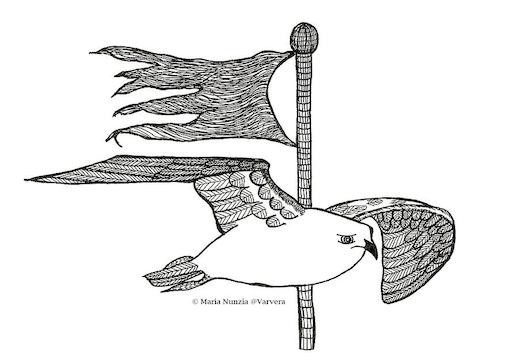An extract from Field Notes From The Edge by Paul Evans
. . . . EME . . S are the only letters of ‘amusements’ left above glass doors behind the sandbags. Inside the arcade, the lights on the gaming machines are still on, I suppose for ghost punters, playing the lurid mathematics of onearm-banditry. Next door, the Golden Sands is boarded up. All the identical green caravans are empty, except one. On the seafront, a red warning flag, shredded like a forgotten socialist republic, thrashes from its pole above three cars, steamed up, rocking in the wind bansheeing from the sea.
One car leaves, another arrives. Someone gets out, suddenly thumped by a gust and a bucket of rain, trying to look casual leaning on the rail. The waves are steely green, their ridges flying spindrift. All down the bay from way out to sea they come charging ashore, north-east to south-west, terrifyingly beautiful. A stone’s throw from the promenade is an island built to stumble the waves before they strike the front. Behind black rocks the sea smashes its endlessly renewed face and on a narrow causeway connecting sea wall and breakwater, two gulls lift and drop and a lone sanderling stands watching them. The rail-leaner lets go and crabs back to the car: sandwiches, flask of tea, turns the radio up.
The sea is so far in, too far. A spring tide fills the estuary between mountains to wedge them apart and let the uncoiling thing from the ocean ram up the crack. For now, the shingle holds the shore together and the gale screams overhead and hums through the rail. In the cars they watch the rain ease and waves diminish and a young couple in matching red wellingtons walk along the front chased by an empty plastic bottle. In a few minutes they return, resolutely in step against the wind, frightened off by spume.
The promenade ends in steps down to the shingle, now hardly a span from the waves, and an outcrop of rocks where a white cloud has formed. The wind whips it up in gobs and spits it landwards like firefighting foam on a crashed aeroplane. The spume may have been caused by oil discharged at sea or stormwater full of sewage and detergent but this has a meringuey lightness which suggests it was created by phytoplankton or algal blooms. A microscopic alga, Phaeocystis globosa, sometimes free-moving with its own flagella, can also create colonies, brown scum, thousands of ball-shaped cells surrounded by a mucus membrane of carbohydrate gel. Phaeocystis has a globally fundamental role cycling carbon and sulphur in the oceans. In spring, influenced by high levels of nitrogen and other pollutants which nourish phytoplankton, these blooms become so vast they are visible from space satellites. Caught in storms, wave turbulence churns the proteins, lignins and lipids in the algal colony’s gel into foaming agents, trapping air in the surf zone where the bubbles of spume stick to each other through surface tension and are blown ashore.
Red-welly couple are heads down into the wind, unable to stand upright. At first, they think the spume looks like fun, bubble-bath, disco foam. They will take photos of each other playing with it, chucking it around like snow. Remember Ibiza? Well this is Wales, in the gales! At last, here is something to break the spell of the storm in this little necrophiliac seaside town; something happily random to show their friends. Then they find themselves in it.
The spume is animated: creeping across rocks, crouching in the corner by the steps and sliding under the rail to pulse like snaking musculature across the path. White but slightly soiled, not pure like spindrift, it is searching them out. Clumps of flob in the wind, catching on their clothes, eyelashes and lips; it begins to repulse them. They shut their mouths and hold their breaths because they can’t make out what the substance is: something with all the qualities of mattress stuffing, mousse, fog, fat, fleece, spit, spunk, spray. Is it toxic? Is it alive?
Phaeocystis, sea, storm, shit, washed from land or dumped by ships, climate change warming the oceans: spume is more than coincidence. Indifferent like snow, intentional like a swarm, each delicate bubble encased in a meniscus of water and algal slime is attached to others to form a mass, but containing what? In the news, a massive algal foam on an Australian beach concealed venomous sea snakes. Here, is it only air? Inside each bubble there may be microscopic fragments of plankton rattling around. Inside each tiny film may be the kind of evolutionary turmoil in which eukaryotic cells – the ones with a nucleus – formed from Frankenstein bits of older organisms shaken together in foaming storms 2 billion years ago. Each bubble is an evolutionary possibility; the stuff of tempests; a quantum state between nothingness; a life. And then…pop!
Red-welly couple are disgusted and struggle back along the front against the wind. They don’t see the gull cruising at shoulder height also against the wind but with such indolent ease like a watchful mugger. They don’t see the clouds fracture and a bolt of sunlight hit the waves. They don’t speak their fear to each other but push on to the public toilets where they split up and even in the cold, stinky dankness of the bogs, find relief in hot water washing the spume’s potentiality from their hands and faces. What will become of them, now they’ve been contaminated, impregnated . . . turned?
Pick up a copy of the book from our shop here
